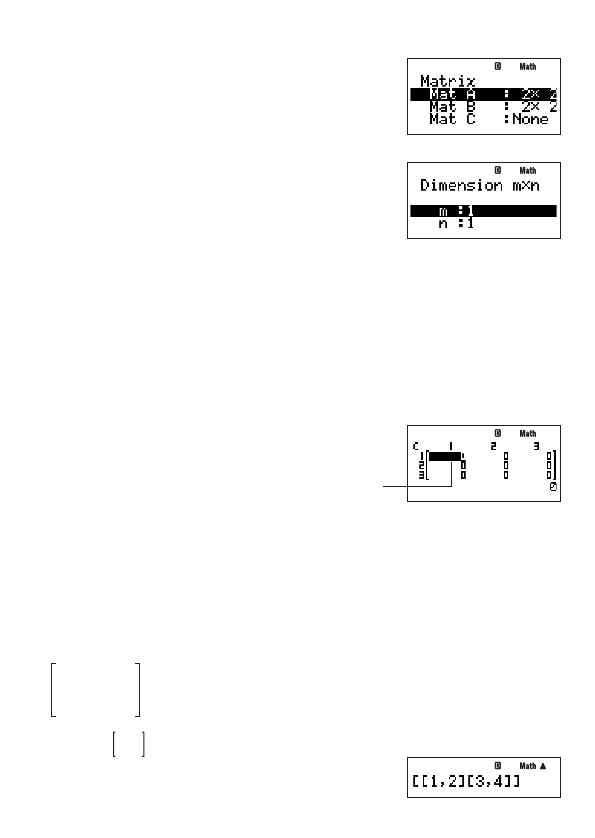
E-60
A
Using the Matrix Editor Screen to Input Matrix Data
1. Press
z
– {MATRIX}
1
(EDIT) to display the matrix
memory area menu.
• A memory area that already contains a matrix will show
the dimensions of its matrix (like 2 × 2), while an area that
is empty will be indicated by “None”.
2. Use
c
and
f
to move the highlighting to the matrix you want to use for data input.
3. Press
E
.
• This displays a screen for specifying the dimensions of
the matrix.
m
is the number of rows, while
n
is the number
of columns.
Note
If you select a memory area that already contains a matrix in step 2, pressing
E
will display the matrix editor screen so you can edit the matrix. If you want to delete
the existing matrix and make a new one with different dimensions, press
e
or
z
1
(Dim) in place of
E
in step 3.
4. Specify the dimensions of the matrix you want to create, up to a maximum of 10 rows
and 10 columns.
• To specify the number of rows, move the highlighting to
m
, input a value and then press
E
. This will cause the highlighting to move to
n
.
• Input a value for
n
to specify the number of columns and then press
E
.
• You can use
c
and
f
to move the highlighting between
m
and
n
.
5. After inputting the row and column values you want, press
E
.
• This will display the matrix editor screen.
Cursor
6. On the matrix editor screen, input values into the cells of the matrix.
• Use the cursor keys to move the cursor to the cell you want and then input a value.
After inputting a value, press
E
to register it.
7. After inputting all the values you want, press
J
.
A
Using the Value Assignment Command (
/
) to Input Matrix
Data
1. On the COMP Mode calculation screen, use the following syntax to input the matrix you
want to input into matrix memory.
a
11
a
12
... a
1n
a
21
a
22
... a
2n
a
m1
a
m2
... a
mn
...
...
...
[[a
11
, a
12
, ..., a
1n
][a
21
, a
22
, ..., a
2n
] ... [a
m1
, a
m2
, ..., a
mn
]]
• Inputting
1 2
3 4
, for example, can be performed using the following key operation.
Si
([)
Si
([)
1,2
S
6
(])
Si
([)
3,4
S
6
(])
S
6
(])


















